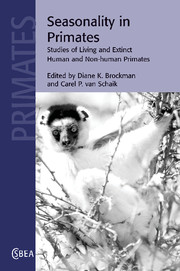Book contents
- Frontmatter
- Contents
- List of contributors
- Preface
- Part I Introduction
- Part II Seasonal habitats
- Part III Seasonality and behavioral ecology
- 3 The influence of seasonality on primate diet and ranging
- 4 Seasonality in predation risk: varying activity periods in lemurs and other primates
- 5 Physiological adaptations to seasonality in nocturnal primates
- 6 Seasonality and long-term change in a savanna environment
- 7 Day length seasonality and the thermal environment
- 8 Seasonality in hunting by non-human primates
- 9 Human hunting seasonality
- Part IV Seasonality, reproduction, and social organization
- Part V Seasonality and community ecology
- Part VI Seasonality and human evolution
- Index
- References
6 - Seasonality and long-term change in a savanna environment
Published online by Cambridge University Press: 10 August 2009
- Frontmatter
- Contents
- List of contributors
- Preface
- Part I Introduction
- Part II Seasonal habitats
- Part III Seasonality and behavioral ecology
- 3 The influence of seasonality on primate diet and ranging
- 4 Seasonality in predation risk: varying activity periods in lemurs and other primates
- 5 Physiological adaptations to seasonality in nocturnal primates
- 6 Seasonality and long-term change in a savanna environment
- 7 Day length seasonality and the thermal environment
- 8 Seasonality in hunting by non-human primates
- 9 Human hunting seasonality
- Part IV Seasonality, reproduction, and social organization
- Part V Seasonality and community ecology
- Part VI Seasonality and human evolution
- Index
- References
Summary
Introduction
The emergence and spread of savannas in Africa during the past five million years is often cited as a major factor in hominid evolution. Tropical savannas are different from forests in having less rainfall, which is strongly seasonal and often very unpredictable, even within seasons (Bourliere & Hadley 1983; Solbrig 1996). Human ancestors are thought to have moved into savannas as a response to cooling and drying climates, and the exigencies of the savanna environment – including the marked seasonal changes in plant food availability – are often cited as key selective pressures shaping the hominid lineage (see reviews and references in Foley [1987, 1993], Potts [1998a, 1998b], Klein [1999], and Chapters 4, 5, and 17). This scenario invites a careful examination of responses to seasonality in extant savanna-dwelling primates.
Like most vertebrates, the large majority of primate species exhibit reproductive seasonality that reflects the seasonality of their habitats (see review in Chapter 11). Indeed, among savanna-dwelling primates, there are only two exceptions to the rule of seasonal reproduction: humans and baboons (genus Papio). This shared characteristic – the ability to reproduce throughout the year in seasonal environments – may be related to the extraordinary success of these two genera. While only humans (and their commensals) have spread across the globe, baboons have achieved a nearly continental distribution in Africa.
- Type
- Chapter
- Information
- Seasonality in PrimatesStudies of Living and Extinct Human and Non-Human Primates, pp. 157 - 196Publisher: Cambridge University PressPrint publication year: 2005
References
- 70
- Cited by



